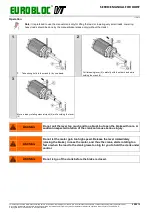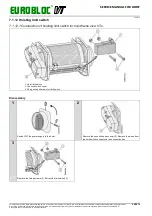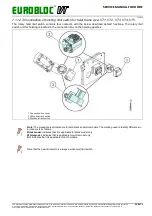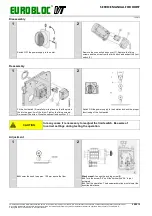
EUROBLOC
SERVICE MANUAL FOR HOIST
116/212
This document and the information contained herein, is the exclusive property of Verlinde S.A.S. and represents a non-public, confidential and proprietary trade secret that
may not be reproduced, disclosed to third parties, altered or otherwise employed in any manner whatsoever without the express written consent of Verlinde S.A.S.
Copyright © (2013) Verlinde S.A.S. All rights reserved.
06/2015
Note: Overspeed activates the drum brake if equipped with an overspeed brakeVT3. If overspeed drum brake
is activated, further lowering is rejected.
WARNING
Ensure that the brake temperature does not increase in an uncontrolled
manner.
Lowering the load
1
2
Pull the lever arm (2) carefully to open the brake and release
immediately when motor starts to rotate.
Pull and release a few times to study how the rotational speed
is growing.
Once known how the rotational speed behaves, open the
brake shortly and close again before the rotational speed
reaches the maximum using the lever arm (2).
Repeat the procedure until the load is lowered safely to the
floor.
CAUTION
Let the brake cool down for at least one minute after five times manually
opening the brake.
CAUTION
When the brake temperature exceeds 100
°°°°
C (water drop boils), let it cool down
for a longer period at higher intervals (for example, after 4 times opening the
brake). Overheating the brake damages the friction material and the load may
drop.
7.1.11 Manual crank
Manual brake release and manual crank is used to move the load in case of power failure.
Note: In hoist models that are equipped with two hoisting motors (and thus with two main brakes), both brakes
must be manually opened with levers simultaneously and both motors must be equipped with a crank. This
requires two persons to carry out the action.





































